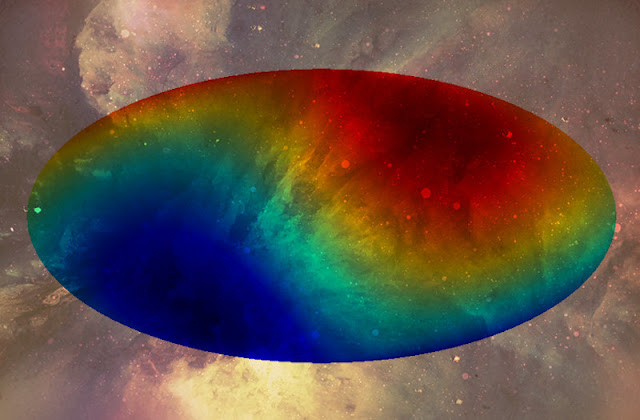Scientists have long observed an apparent gradient in the cosmic microwave background but have been unable to determine how much is real and how much is perceived. USC Dornsife researchers appear to have found a way to an answer.
 |
| A remnant of the Big Bang, the cosmic microwave background appears to harbor a gradient across the universe, a feature that has puzzled cosmologists for decades [Credit: Matthew Savino] |
USC Dornsife scientists Siavash Yasini and Elena Pierpaoli may have found a way to nail down an answer.
Made most famous perhaps by Edwin Hubble, who used it to show that the universe is expanding, the Doppler effect is the apparent shift in the frequency of electromagnetic waves due to the motion of bodies traveling swiftly through space. Waves such as electromagnetic radiation—light waves, X-rays, microwaves, etc.—appear to shift in energy, with those moving toward an observer appearing to be higher in energy, or hotter, than they really are. The opposite is true for waves moving away from the observer, which appear colder.
Scientists looking at the sky see space trailing behind Earth appearing colder than space up ahead, but it's not clear if that's only the Doppler effect or an observation of a true difference in CMB temperature. It's a puzzle that has persisted for decades.
Because the CMB is leftover energy from the Big Bang—when the entire universe exploded outward from a single point—cosmologists have assumed it is dispersed evenly. The appearance of two poles in the universe, one warmer than the other, must therefore be a result of the Doppler effect, a result of the solar system careening through space.
"We think that one side of the CMB only looks hotter because we are moving towards it, and the opposite side looks colder because we are moving away from it," said Yasini, a Ph.D. student in physics and astronomy.
Astrophysicists measuring the solar system's velocity relative to the CMB adjust their calculations based on this assumption, as do cosmologists studying the Big Bang and conditions shortly after.
But this might be a mistake after all.
"If there is an intrinsic dipole in the CMB—that is, if one side of the sky is actually partially hotter than the opposite side—the velocity we assign the solar system with respect to the CMB would be incorrect," Yasini said. This would affect how scientists measure the speed of distant objects such as galaxies, and theories about what happened moments after the Big Bang could be shaken.
Running calculations for a different but related study, Yasini and Professor of Physics and Astronomy Pierpaoli, who is Yasini's graduate school mentor, found an interesting detail: The frequency spectrum of the CMB averaged across the sky will differ if the dipole is real and not just a result of the Doppler effect.
In other words, if the CMB is, in fact, hotter at one end of the universe than the other, the average temperature measured across the whole sky will be slightly different than if the CMB is actually uniform.
Yasini and Pierpaoli's findings will allow cosmologists undertaking the next generation of CMB surveys to determine the nature of the CMB dipole for the first time ever, solving the puzzle.
"Now that we have a mathematical basis for finding an answer, it just remains to make the observations," Pierpaoli said.
If it turns out a portion of the dipole is real and not just a result of the Doppler effect, astrophysicists and astronomers will have to recalibrate all of their measurements to get a more accurate view of the observable universe.
Just as important, cosmologists studying the Big Bang and conditions in the very early universe will have new directions to explore to understand how and why the CMB is dispersed unevenly, and how the universe came to be as it now is.
Author: Darrin S. Joy | Source: University of Southern California [March 07, 2018]
